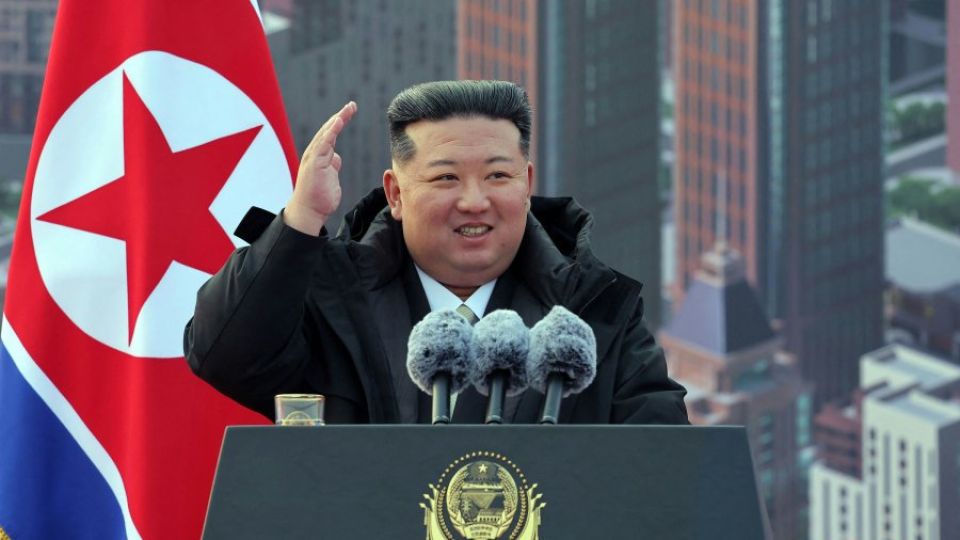February 17, 2025
SEOUL – North Korean leader Kim Jong-un has laid out a blueprint to expand Pyongyang’s urban core eastward and push for full-scale transformation, calling it the ruling party’s next key project after completing his 2021-2025 plan to build 50,000 houses in the capital.
Kim outlined his grand vision for the capital city during Sunday’s groundbreaking ceremony for the final phase of Pyongyang’s 50,000-unit housing project, North Korean state media reported on Monday.
The final stage of the project is to construct 10,000 units in the Hwasong district, a newly developed residential area in northeastern Pyongyang. The 50,000-unit construction project is part of the five-year national economic plan, first proposed by Kim at the 8th Workers’ Party Congress in January 2021.
Kim said he intended to “briefly summarize a few key points regarding our party’s policy plans for capital city construction” in his Korean-language speech.
“We will complete the construction in the Hwasong district, and as the follow-up phase, push forward a policy to extend Pyongyang’s street layout in the direction of Kangdong in earnest,” Kim said, without elaborating on his plan to drive urbanization to the east.
Kangdong County is a suburban area northeast of the city that borders South Pyongan Province.
In 2021, Choson Sinbo, a pro-North newspaper produced by the Chongryon community in Tokyo, reported that upon the completion of Pyongyang’s 50,000 housing units, “the city’s urban layout will expand eastward, westward, and northward.”
In his speech, Kim also said “At the same time, we will set forth projects to transform underdeveloped areas within the capital region and outdated living and cultural areas in the suburbs.”
Kim pointed to Tungme-dong in Songyo district, Wolhyang-dong in Moranbong district, and Hadang-dong in Hyongjesan district in Pyongyang as underdeveloped areas that he planned to prioritize for development.
“We intend to eliminate and revamp all elements in the overall urban structure that do not befit the dignity of the capital,” Kim said. “These plans will be reported to the (next) Party Congress and handed over as a key project for the next Party Central Committee.”
Ever since Kim’s five-year plan was unveiled, there has been progress in stages, starting with the Songsin and Songhwa areas in 2021 and the three-stage Hwasong district project from 2022 to 2024. While the second stage has been finished, the completion work on the third stage is still underway.
Kim prepares for party congress
The Unification Ministry on Monday said that Kim put more value on tangible outcomes achievable in a short time frame prior to the next party congress, which is expected to review the achievements of the 2021-2025 development plans and propose new initiatives.
“The construction of houses is a sector where palpable results can be obtained relatively easily if manpower and materials are invested,” the Unification Ministry spokesman Koo Byung-sam told a regular press briefing. “It appears North Korea is putting its domestic resources intensively into the area to zero in on producing tangible results first.”
In that context, when Kim introduced the five-year economic development plan in 2021, the housing sector stood out with its specific numerical target, which involved 25,000 dwelling units to be constructed in the Komdok mining district of South Hamgyong Province.
“There has been an aggressive push for a construction boom from the beginning of the year to guarantee the success of tasks presented by the 8th Party Congress, to enhance achievements, consolidate the regime and lay the ground for holding the 9th Party Congress,” University of North Korean Studies professor Yang Moo-jin said.
From January to mid-February, Kim made 12 public appearances, including four tied to construction in Kangdong County, South Hamgyong Province and North Pyongan Province.
“The construction of high-class new towns in Pyongyang aims to generate loyalty among Pyongyang residents, and the 20×10 policy is used to coax local people’s complaints in impoverished rural regions,” Yang said. “Both schemes take advantage of a construction boom that can yield concrete results in a brief period.”
Kim Jong-un announced the “Regional Development 20×10 Policy” in January 2024 with the goal of building local industrial factories in 20 counties every year to improve material and cultural living standards across the country within 10 years.


